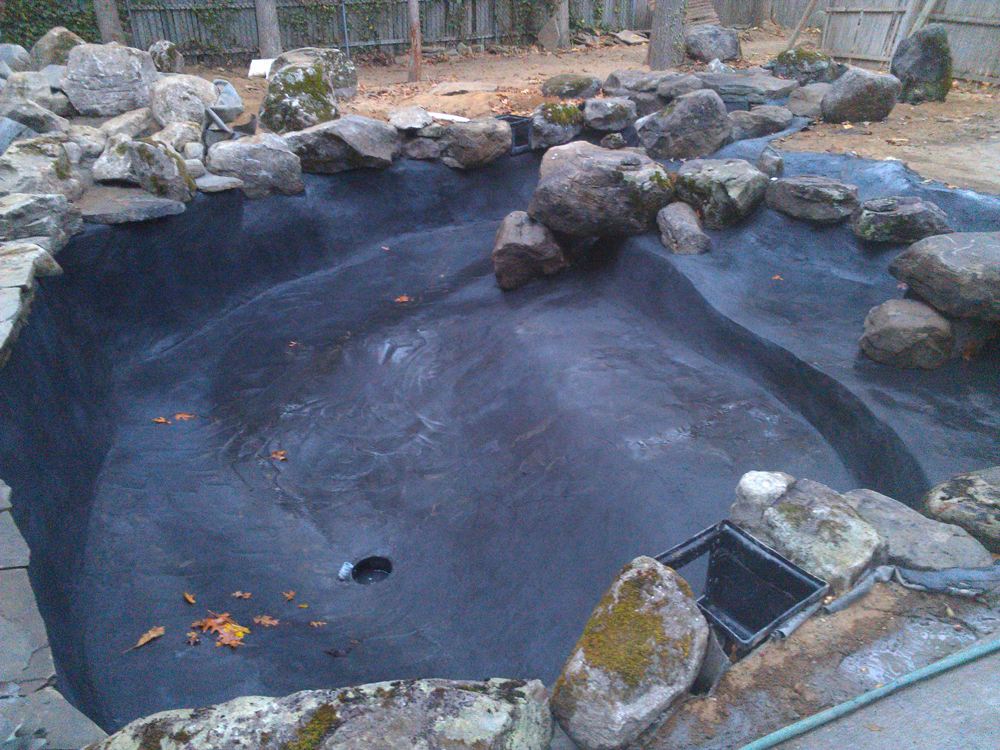Ponds 102 Chapter 2
Pond Sizing
How big should your pond be? This may be the most common question asked by the new pond builder, and the answer is deceptively simple – as big as possible. When building the Garden Pond, we’re trying to emulate the natural conditions that keep natural ponds clean and clear. The bigger the pond, the easier it is to attain balance, and balance is key. When the plants and microorganisms in the pond consume all excess nutrients and fish wastes, the balance between nutrient consumption and nutrient input keeps algae down, the water clear and water quality excellent. As you can imagine, smaller ponds tend to have a greater number of fish per gallon, and people love to feed fish, and plants tend to hide those fish from view, so smaller ponds tend to be overfed and underplanted. When everything’s working, any and all food in the pond ends up as nitrates - plant food - so if there aren’t enough pretty plants to consume the nitrates, algae will bloom profusely and constantly.

Paradoxically, the larger the pond, the easier it is to achieve the balance between bacteria, fish and plants. There are usually fewer fish per gallon and more room for plants. The deeper the pond, the more water there is relative to the surface area, the less quickly the water heats up and cools down, and that’s less stressful for all the pond’s many inhabitants, fish, plants and microorganisms alike. The deeper the pond, the cooler it tends to stay in the summer and warmer in winter. Cooler temps slow the growth rate of algae, and cooler water can hold more oxygen, critical in the warmest weather. Conversely, in freezing winters the deepest water is usually a little warmer, easier on the fish during their long hibernation under ice.
Now, everyone has space limitations, and there may be depth restrictions in your area as well, so it makes sense to think about how you’ll be able to maximize the volume of the pond within the constraints. The way to get the most water volume in a given space and depth is to make the sides of the pond as vertical as possible down to the maximum depth, a common technique in Koi Pond construction that offers benefits to the Garden Pond owner as well. We’ll talk about Pond Profiles to maximize volume in Ponds 102 Chapters 5, 6 and 7, right up ahead.
How big should your pond be? This may be the most common question asked by the new pond builder, and the answer is deceptively simple – as big as possible. When building the Garden Pond, we’re trying to emulate the natural conditions that keep natural ponds clean and clear. The bigger the pond, the easier it is to attain balance, and balance is key. When the plants and microorganisms in the pond consume all excess nutrients and fish wastes, the balance between nutrient consumption and nutrient input keeps algae down, the water clear and water quality excellent. As you can imagine, smaller ponds tend to have a greater number of fish per gallon, and people love to feed fish, and plants tend to hide those fish from view, so smaller ponds tend to be overfed and underplanted. When everything’s working, any and all food in the pond ends up as nitrates - plant food - so if there aren’t enough pretty plants to consume the nitrates, algae will bloom profusely and constantly.

Paradoxically, the larger the pond, the easier it is to achieve the balance between bacteria, fish and plants. There are usually fewer fish per gallon and more room for plants. The deeper the pond, the more water there is relative to the surface area, the less quickly the water heats up and cools down, and that’s less stressful for all the pond’s many inhabitants, fish, plants and microorganisms alike. The deeper the pond, the cooler it tends to stay in the summer and warmer in winter. Cooler temps slow the growth rate of algae, and cooler water can hold more oxygen, critical in the warmest weather. Conversely, in freezing winters the deepest water is usually a little warmer, easier on the fish during their long hibernation under ice.
Now, everyone has space limitations, and there may be depth restrictions in your area as well, so it makes sense to think about how you’ll be able to maximize the volume of the pond within the constraints. The way to get the most water volume in a given space and depth is to make the sides of the pond as vertical as possible down to the maximum depth, a common technique in Koi Pond construction that offers benefits to the Garden Pond owner as well. We’ll talk about Pond Profiles to maximize volume in Ponds 102 Chapters 5, 6 and 7, right up ahead.




